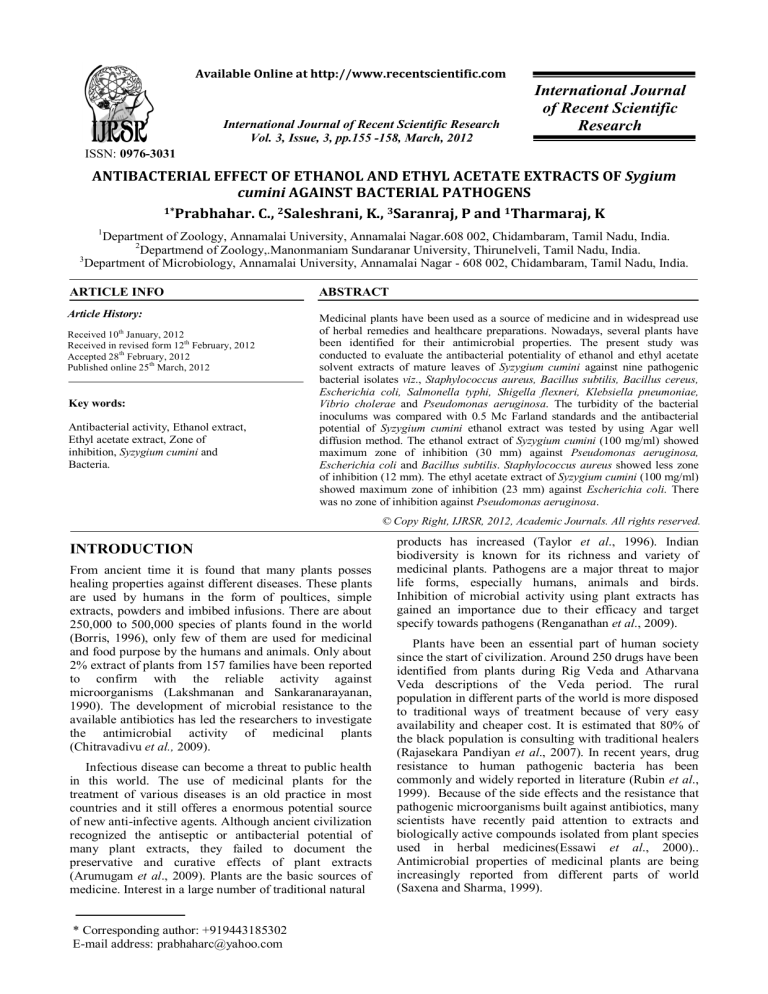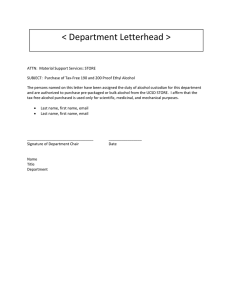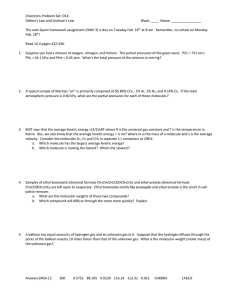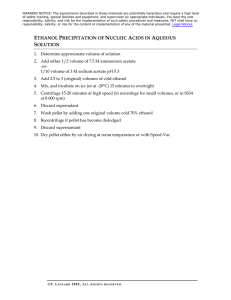
Available Online at http://www.recentscientific.com
International Journal of Recent Scientific Research
Vol. 3, Issue, 3, pp.155 -158, March, 2012
International Journal
of Recent Scientific
Research
ISSN: 0976-3031
ANTIBACTERIAL EFFECT OF ETHANOL AND ETHYL ACETATE EXTRACTS OF Sygium
cumini AGAINST BACTERIAL PATHOGENS
1*Prabhahar. C., 2Saleshrani, K., 3Saranraj, P and 1Tharmaraj, K
1
Department of Zoology, Annamalai University, Annamalai Nagar.608 002, Chidambaram, Tamil Nadu, India.
2
Departmend of Zoology,.Manonmaniam Sundaranar University, Thirunelveli, Tamil Nadu, India.
3
Department of Microbiology, Annamalai University, Annamalai Nagar - 608 002, Chidambaram, Tamil Nadu, India.
ARTICLE INFO
ABSTRACT
Article History:
Medicinal plants have been used as a source of medicine and in widespread use
of herbal remedies and healthcare preparations. Nowadays, several plants have
been identified for their antimicrobial properties. The present study was
conducted to evaluate the antibacterial potentiality of ethanol and ethyl acetate
solvent extracts of mature leaves of Syzygium cumini against nine pathogenic
bacterial isolates viz., Staphylococcus aureus, Bacillus subtilis, Bacillus cereus,
Escherichia coli, Salmonella typhi, Shigella flexneri, Klebsiella pneumoniae,
Vibrio cholerae and Pseudomonas aeruginosa. The turbidity of the bacterial
inoculums was compared with 0.5 Mc Farland standards and the antibacterial
potential of Syzygium cumini ethanol extract was tested by using Agar well
diffusion method. The ethanol extract of Syzygium cumini (100 mg/ml) showed
maximum zone of inhibition (30 mm) against Pseudomonas aeruginosa,
Escherichia coli and Bacillus subtilis. Staphylococcus aureus showed less zone
of inhibition (12 mm). The ethyl acetate extract of Syzygium cumini (100 mg/ml)
showed maximum zone of inhibition (23 mm) against Escherichia coli. There
was no zone of inhibition against Pseudomonas aeruginosa.
Received 10th January, 2012
Received in revised form 12th February, 2012
Accepted 28th February, 2012
Published online 25th March, 2012
Key words:
Antibacterial activity, Ethanol extract,
Ethyl acetate extract, Zone of
inhibition, Syzygium cumini and
Bacteria.
© Copy Right, IJRSR, 2012, Academic Journals. All rights reserved.
INTRODUCTION
From ancient time it is found that many plants posses
healing properties against different diseases. These plants
are used by humans in the form of poultices, simple
extracts, powders and imbibed infusions. There are about
250,000 to 500,000 species of plants found in the world
(Borris, 1996), only few of them are used for medicinal
and food purpose by the humans and animals. Only about
2% extract of plants from 157 families have been reported
to confirm with the reliable activity against
microorganisms (Lakshmanan and Sankaranarayanan,
1990). The development of microbial resistance to the
available antibiotics has led the researchers to investigate
the antimicrobial activity of medicinal plants
(Chitravadivu et al., 2009).
Infectious disease can become a threat to public health
in this world. The use of medicinal plants for the
treatment of various diseases is an old practice in most
countries and it still offeres a enormous potential source
of new anti-infective agents. Although ancient civilization
recognized the antiseptic or antibacterial potential of
many plant extracts, they failed to document the
preservative and curative effects of plant extracts
(Arumugam et al., 2009). Plants are the basic sources of
medicine. Interest in a large number of traditional natural
* Corresponding author: +919443185302
E-mail address: prabhaharc@yahoo.com
products has increased (Taylor et al., 1996). Indian
biodiversity is known for its richness and variety of
medicinal plants. Pathogens are a major threat to major
life forms, especially humans, animals and birds.
Inhibition of microbial activity using plant extracts has
gained an importance due to their efficacy and target
specify towards pathogens (Renganathan et al., 2009).
Plants have been an essential part of human society
since the start of civilization. Around 250 drugs have been
identified from plants during Rig Veda and Atharvana
Veda descriptions of the Veda period. The rural
population in different parts of the world is more disposed
to traditional ways of treatment because of very easy
availability and cheaper cost. It is estimated that 80% of
the black population is consulting with traditional healers
(Rajasekara Pandiyan et al., 2007). In recent years, drug
resistance to human pathogenic bacteria has been
commonly and widely reported in literature (Rubin et al.,
1999). Because of the side effects and the resistance that
pathogenic microorganisms built against antibiotics, many
scientists have recently paid attention to extracts and
biologically active compounds isolated from plant species
used in herbal medicines(Essawi et al., 2000)..
Antimicrobial properties of medicinal plants are being
increasingly reported from different parts of world
(Saxena and Sharma, 1999).
International Journal of Recent Scientific Research, Vol. 3, Issue, 3, pp. 149 -154, March, 2012
The antimicrobial compounds from plants may inhibit
bacterial growth by different mechanisms than those
presently used. Antimicrobials therefore, may have a
significant clinical value in treatment of resistant
microbial strains (Eloff, 1998). In particular, the
antimicrobial activities of plant oils and extracts have
formed the basis of many applications including raw and
processed food preservation, pharmaceuticals, alternative
medicine, and natural therapies (Hammer et al., 1999).
Determination of antibacterial activity
Preparation of Mc Farland Nephelometer standards
10 test tubes of equal size and good quality have been
thoroughly cleaned and arranged in the test tube stand.
1% chemically pure Sulphuric acid and 1.175% aqueous
solution of Barium chloride was prepared. Slowly and
with constant agitation, the designated amounts of two
solutions were added to the tubes as shown in Table-1 to
make a total volume of 10 ml per tube. The tubes were
sealed. The suspended Barium chloride precipitate
corresponds approximately to homogenous cell densities
per ml throughout the range of standards as shown in
table. Store the Mc Farland standard tubes in the dark at
room temperature. They should stable for 6 months.
Syzygium cumini plants are used in folk therapy in the
treatment of skin, GIT and respiratory problems while
seeds of later plant used in the treatment of diabetic
patients. The (aqueous and ethanolic) extracts of all parts
of Syzygium cumini plants has been carried out on
different microbes for antibacterial study which contains
other chemical constituents of plants. The present study
was aimed to evaluate the antibacterial potentiality of
ethanol and ethyl acetate extract of Syzygium cumini
against nine bacterial pathogens and phytochemical
analysis of Syzygium cumini.
Inoculum preparation
Bacterial inoculum was prepared by inoculating a loopful
of test organisms in 5 ml of Nutrient broth and incubated
at 37C for 3-5 hours till a moderate turbidity was
developed. The turbidity was matched with 0.5 Mc
Farland standards.
MATERIALS AND METHODS
Determination of antibacterial activity (Agar well
Diffusion Method or Cup Plate Method)
Collection and Drying of plant materials
Mature leaves of Syzygium cumini were collected from
Dhesiga Perumal temple at Chengelpet, Tamil Nadu. The
leaves of Syzygium cumini were washed thoroughly three
times with water and once with distilled water. The plant
materials were air dried and powdered. The powdered
samples were hermetically sealed in separate polythene
bags until the time of extraction.
Muller Hinton agar plates were inoculated with test
organisms by spreading the bacterial inoculum on the
surface of the media. Wells (8 mm in diameter) were
punched in the agar. Ethanol and ethyl acetate extracts
with different concentrations (25 mg/ml, 50mg/ml,
75mg/ml and 100 mg/ml) were mixed with 1 ml of
Table1 Mc Farland Nephelometer standard
Chemical Name / std
Barium chloride (ml)
Sulfuric acid (ml)
Approximate cell
density (x 108/ml)
0.5
0.05
10
1.5
1
0.1
9.9
3
2
0.2
9.8
6
3
0.3
9.7
9
4
0.4
9.6
12
5
0.5
9.5
15
6
0.6
9.4
18
7
0.7
9.3
21
8
0.8
9.2
24
9
0.9
9.1
27
10
1
9
30
Dimethyl sulfoxide (DMSO) and added into the well.
Well containing DMSO alone act as a negative control.
The plates were incubated at 37C for 24 hours. The
antibacterial activity was assessed by measuring the
diameter of the zone of inhibition (in mm).
Preparation of plant extract
40 g of powdered leaves were extracted successively with
200 ml of ethanol at 56-60C and ethyl acetate at 40-50C
in Soxhelet extractor until the extract was clear. The
extracts were evaporated to dryness and the resulting
pasty form extracts were stored in a refrigerator at 4C for
future use (Chessbrough, 2000).
RESULTS AND DISCUSSION
The antibacterial activities of ethanol and ethyl acetate
extract of Syzygium cumini was assayed against various
bacterial pathogens and the results were showed in Table
1 and Table 2. The zone of inhibition against ethanol
extract was Staphylococcus aureus (15 mm), Bacillus
cereus (18 mm), Bacillus subtilis (33 mm), Salmonella
typhi (28 mm), Shigella flexneri (28 mm), Escherichia
coli (33 mm), Klebsiella pneumoniae (23 mm), Vibrio
cholerae (23 mm) and Pseudomonas aeruginosa (33
mm). The zone of inhibition against ethyl acetate extract
was Staphylococcus aureus (20 mm), Bacillus cereus (14
mm), Bacillus subtilis (16 mm), Salmonella typhi (21
mm), Shigella flexneri (18 mm), Escherichia coli (26
mm), Klebsiella pneumoniae (23 mm), Vibrio cholerae
Test microorganisms
Nine pathogenic bacteria, viz., Staphylococcus aureus,
Bacillus cereus, Bacillus subtilis, Escherichia coli,
Salmonella typhi, Shigella flexneri,
Klebsiella
pneumoniae, Vibrio cholerae and Pseudomonas
aeruginosa were used during the present study and were
obtained from SGS India laboratories – Thoraipakkam,
Chennai – 96. The cultures were sub-cultured and
maintained on Nutrient agar slants and stored at 4C.
156
International Journal of Recent Scientific Research, Vol. 3, Issue, 3, pp. 149 -154, March, 2012
and concluded that and concluded that the ethanol extract
showed more inhibitory activity against human
(16 mm) and Pseudomonas aeruginosa showed no zone
of inhibition.
Table 1 Antibacterial activity of Syzygium cumini ethanol extract against bacterial pathogens
S. No.
1
2
3
4
5
6
7
8
9
Organisms
Pseudomonas aeruginosa
Escherichia coli
Shigella flexneri
Staphylococcus aureus
Klebsiella pneumoniae
Salmonella typhi
Vibrio cholerae
Bacillus cereus
Bacillus subtilis
Concentration of extract and zone of inhibition
25 mg
50 mg
75 mg
100 mg
NZ
18 mm
28 mm
33 mm
12 mm
21 mm
29 mm
33 mm
NZ
16 mm
23 mm
28 mm
NZ
8 mm
10 mm
15 mm
NZ
12 mm
15 mm
23 mm
11 mm
19 mm
24 mm
28 mm
NZ
10 mm
16 mm
23 mm
NZ
7 mm
12 mm
18 mm
13 mm
21 mm
29 mm
33 mm
NZ – No zone
Table 2 Antibacterial activity of Syzygium cumini ethyl acetate extract against bacterial pathogens
S. No.
1
2
3
4
5
6
7
8
9
Organisms
Pseudomonas aeruginosa
Escherichia coli
Shigella flexneri
Staphylococcus aureus
Klebsiella pneumoniae
Salmonella typhi
Vibrio cholerae
Bacillus cereus
Bacillus subtilis
Concentration of extract and zone of
inhibition
25 mg
50 mg
75 mg
100 mg
NZ
NZ
NZ
NZ
10 mm
16 mm
21 mm
26 mm
7 mm
11 mm
14 mm
18 mm
9 mm
12 mm
16 mm
20 mm
12 mm
17 mm
20 mm
23 mm
10 mm
14 mm
18 mm
21 mm
NZ
NZ
11 mm
16 mm
NZ
NZ
8 mm
14 mm
NZ
10 mm
15 mm
16 mm
NZ – No zone
Sumathi and Pushpa (2007) evaluated the antibacterial
activity of some Indian medicinal plants. The aqueous
extract of Acalypha indica was tested against different
bacterial pathogens. The aqueous extract of Acalypha
indica showed 9 mm inhibition zone to Escherichia coli
and no zone was showed against Staphylococcus aureus,
Salmonella typhi and Shigella flexneri. Alcoholic extract
of Acalypha indica showed 10 mm inhibition zone
towards Staphylococcus aureus and Salmonella typhi.
pathogenic bacteria when compared to ethyl acetate
extract. The findings of the present study coincide with
the results of Saranraj et al. (2010). The findings of the
present study showed that the ethanol was best solution
for extracting the effective antifungal substances from the
medicinal plant Syzygium cumini than ethyl acetate. This
could be related to the presence of bioactive metabolites
present in Syzygium cumini which are not soluble in ethyl
acetate but they can be soluble in ethanol.
In this study ethanol was best solution for extracting
the effective anti microbial substances from the medicinal
plant Syzygium cumini than ethyl acetate. The ethanol
extract of Syzygium cumini showed effective results
against all test organisms but the ethyl acetate extract of
Syzygium cumini was low effective against all the
microorganisms. This could be related to the presence of
bioactive metabolites present in Syzygium cumini which
are not soluble in ethyl acetate but they can be soluble in
ethanol.
Siva Sakthi et al. (2011) evaluated the antibacterial
potentiality of ethanol and ethyl acetate solvent extracts of
mature leaves of Datura metel against nine pathogenic
bacteria isolates viz., Staphylococcus aureus, Bacillus
subtilis, Bacillus cereus, Escherichia coli, Salmonella
typhi, Shigella flexneri, Klebsiella pneumoniae, Vibrio
cholerae and Pseudomonas aeruginosa. The ethanol
extract of Datura metel (100 mg/ml) showed maximum
zone of inhibition (26 mm) against Pseudomonas
aeruginosa, Escherichia coli and Bacillus subtilis.
Staphylococcus aureus showed less zone of inhibition (8
mm). The ethyl acetate extract of Datura metel (100
mg/ml) showed maximum zone of inhibition (19 mm)
against Escherichia coli. There was no zone of inhibition
against Pseudomonas aeruginosa. The findings of the
present study coincide with the results of Siva Sakthi et
al. (2011). In this study, ethanol was best solvent for
extracting the effective antifungal substances from the
medicinal plant Syzygium cumini than ethyl acetate. This
could be related to the presence of bioactive metabolites
present in Datura metel which are not soluble in ethyl
acetate but they can be soluble in ethanol.
Some studies concerning the effectiveness of
extraction methods highlight that methanol extract yields
higher antibacterial activity than n-hexane and ethyl
acetate (Sastry and Rao, 1994).Whereas other report that
chloroform is better than methanol and benzene (Febles et
al.,1995) . It is clear that using organic solvents provides
a higher efficiency in extracting compounds for
antimicrobial activities compared to water based method
(Lima-Filo et al ., 2002).
Saranraj et al. (2010) investigated the antibacterial
potentiality of ethanol and ethyl acetate extract of
Acalypha indica leaves against human pathogenic bacteria
Saranraj et al. (2011) screened the pharmacological
activity of the ethanol and ethyl acetate extract of Datura
157
International Journal of Recent Scientific Research, Vol. 3, Issue, 3, pp. 149 -154, March, 2012
metel and Acalypha indica for its antifungal activity
against pathogenic fungi. Six different fungal isolates viz.,
Candida albicans, Candida glabrata, Aspergillus
fumigatus, Aspergillus flavus, Aspergillus niger and
Penicillium chrysogenum were tested for its antifungal
activity. The collected leaf samples were powdered and
the bioactive compounds were extracted by using ethanol
and ethyl acetate in a Soxhelet extractor. The antifungal
activity was determined by using Well diffusion method.
Ethanol and ethyl acetate extracts with different
concentrations were mixed with 1 ml of Dimethyl
sulfoxide and added into the well. The inhibitory effect of
ethanol extract was relatively high when compared to
ethyl acetate extract. The extract of Datura metel showed
maximum zone of inhibition against fungal pathogens
when compared to Acalypha indica.
form the coast of Tenerife (in Spanish). Anuria del
Estudios Canarios 34: 181-192.
Hammer, K.A., Carson, C.F., and Riley, T.V. 1999.
Antimicrobial activity of essential oils and other plant
extracts. Journal of Applied Microbiology. 86: 985990.
Iyengar, M.A. 1995. Study of drugs. 8th edition, Manipal
Power Press, Manipal, India: 2.
Lakshmanan, K.K., Sankaranarayanan, A.S. 1990.
Antifertility herbs used by the tribals in Anaikatty,
Coimbatore District, Tamilnadu. Journal of
Economic and Taxonomic Botany, 14: 171-173.
Lima-Filo J.V.M., Carvola A.F.F.U., Freitas S.M. 2002.
Antibacterial activity of extract of six macro algae
from the North eastern Brazilian Coast. Brazilian
Journal of Microbiology. 33: 311-313.
Rajasekara Pandiyan, M., Sharmaila Banu, G., and
Kumar, G. 2007. Antimicrobial activities of natural
honey from medicinal plants on antibiotic resistant
strains of bacteria. Asian Journal of Microbiology,
Biotechnology and Environmental Science. 9: 219224.
Renganathan, S., Rajesh Kanna, C., Baskar, G. 2009.
Studies on antibacterial activity of Leucas aspera
extracts. Research Journal of Biological Science.
1(4): 236-241.
Rubin, R.J., Harrignton, C.A., Poon, A., Dietrich, K.,
Grene, J.A., and Moiduddin, A. 1999. The economic
impact of Staphylococcus infection in New York City
hospitals. Emerging infections diseases. 5: 9-17.
Saranraj, P., D. Stella and Sajani Samuel. 2010.
Antibacterial potentiality of ethanol and ethyl acetate
extract of Acalypha indica against human pathogenic
bacteria. Journal of Ecobiotechnology, 2 (7): 23 -27.
Saranraj, P., S. Siva Sakthi and M.Geetha. 2011.
Pharmacological screening of Datura metel and
Acalypha indica for its Antifungal activity against
fungal pathogens. International Journal of
Pharmaceutical Science and Health Care, 1 (2): 15 30.
Sastry and Rao. 1994. Antibacterial substance from
marine algae: Successive extraction using benzene,
chloroform and methanol. Bot. Mar. 37: 357-360.
Saxena and Sharma, R.N. 1999. Antibacterial activity of
essential oils of Lankan aculeate. Fitoterapia, 70 (1):
59-60.
Siddiqui, A.A., and Ali, M. 1997. Practical
pharmaceutical chemistry. First edition, CBS
Publishers and distributors, New Delhi: 126-131.
Siva Sakthi, S., P.Saranraj and M.Geetha. 2011.
Antibacterial evaluation and phytochemical screening
of Datura metel leaf extracts against bacterial
pathogens. International Journal of Pharmaceutical
and Biological Archives, 2 (4): 1063-1069.
Sumathi and Pushpa. 2007. Evaluation of antibacterial
activity of some Indian medicinal plants. Asian
Journal of Microbiology, Biotechnology and
Environmental Science. 9: 201-205.
Taylor, R.S.L., Manandhar, N.P., and Hudson, B. 1996.
Antiviral activities of Nepalese medicinal plants.
Journal of Ethanopharmacol. 52: 157-163.
CONCLUSION
The study of antibacterial activity of herbal plant extract
of Syzygium cumini showed that the ethanol extract shows
promising antibacterial activity against bacterial human
pathogens when compared to ethyl acetate extract. The
results also indicated that scientific studies carried out on
medicinal plants having traditional claims of effectiveness
might warrant fruitful results. These plants could serve as
useful source of new antimicrobial agents.
Acknowledgement
The authors are deeply indebted to Professor and Head,
Department of Zoology, Annamalai University,
Annamalai Nagar, Tamil Nadu, India for their inspiring
help, constant support and for providing adequate
laboratory facilities in the department to carry out the
research work
References
Arumugam, M., Karthikeayan, S., and Ahmed John, S.
2009. Antibacterial activity of Indonessiella
echioides. Research Journal of Biological Science.
1(3): 157-161.
Borris, R.P. 1996. Natural products research: perspectives
from a major pharmaceutical company. Journal of
Ethnopharmacology, 51: 29-38.
Chessbrough, M. 2000. Medical laboratory manual for
Tropical countries, Linacre House, Jordan Hill,
Oxford.
Chitravadivu, C., Manian, S., Kalaichelvi, K. 2009.
Antimicrobial Studies on Selected Medicinal Plants,
Erode Region, Tamilnadu, India. Middle East Journal
of Scientific Research, 04: 147-152.
Eloff, J.N. 1998. Screening and isolation of antimicrobial
components
from
plants.
Journal
of
Ethanopharmacology. 70: 343-349.
Essawi, T., and Srour, M. 2000. Screening of some
Palestinian medicinal plants for antibacterial activity.
Journal of Ethanopharmacology. 70: 343-349.
Evans, W.C. 2002. Trease and Evan’s Pharmacognosy. 5th
edition, Haarcourt Brace and Company: 336.
Febles, C.L., Arias. A., and Gil-Rodriguez MC. 1995.
Invitro study of antimicrobial activity in algae
(Chlorophyta, Phaeophyta and Rhodophyta) collected
158






